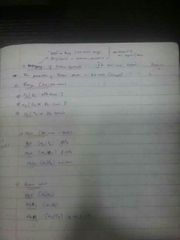![]()
![]()
![]()
Use LEFT and RIGHT arrow keys to navigate between flashcards;
Use UP and DOWN arrow keys to flip the card;
H to show hint;
A reads text to speech;
25 Cards in this Set
- Front
- Back
- 3rd side (hint)
|
Each RBC has how many hemoglobin molecule |
640 million Hb molecules according to slide (though I know it as 250 million Hb) |
|
|
|
Hemoglobin occupies what fraction of RBCs |
One-third (1/3) |
|
|
|
Hemoglobin synthesis starts in what stage of RBCs |
Proerythroblast stage. 65% of Hb is produced in erythroblast 35% of Hb is produced in reticulocyte |
|
|
|
Heme group is located where in the globin chain |
At the end of globin chain |
|
|
|
What is the skeletal structure of the heme group |
Heme= Iron + protoporphyrin The protoporphyrin is composed of 4 pyrrole rings linked by methene group and that are bound to the central iron |
|
|
|
In a polypeptide chain, amino acid are numbered from which end of the chain |
N-terminal part of the chain |
|
|
|
Secondary structure of Hemoglobin |
All globin chains are composed of 9 non-helical sections and 8 helical sections(alpha helix) lettered A-H. The non helical sections are in between the helical sections and are named based on them: NA, AB, BC, CD, etc. |
|
|
|
The shape of each tertiary structure of globin chain is |
Approx. Spherical |
|
|
|
Folding of the secondary structure of globin to tertiary structure occurs where, helical or non helical sections? |
Non-helical sections of secondary structure |
|
|
|
Hemoglobin is produced in what organelles of the RBCs. State it based on heme and globin separately |
● Heme is produced in Mitochondria ● Globin (protein) produced in Ribosome |
|
|
|
Do mature RBCs (erythrocytes) produce hemoglobin |
No, they lack mitochondria (no heme production) and nucleus |
|
|
|
Cofactors for ALA production in Heme synthesis include |
● Vitamin B6 Pyrodoxial phosphate ● Free ferrous iron ● Copper ions |
|
|
|
Which steps of heme synthesis occur in the mitochondria |
1st step (ALA production) and Last 2 steps (coproporphyrinogen 3 -- protoporphyrin -- Heme) |
|
|
|
How many genes are there for globin synthesis? These genes are arranged in how many clusters? These clustered are found which chromosome |
● 8 functional genes for globin chain ● 2 clusters (alpha and beta) Alpha cluster (for alpha and zeta chains) are found on short arm of chromosome 16 Beta cluster (for beta, gamma, delta, epsilon) found on short arm of chromosome 11
|
Switch between beta and alpha |
|
|
Which alpha and beta like chain are seen only in embryos |
Zeta and Epsilon chain |
|
|
|
Mention the 3 Hemoglobin found in embryo (wk1-8) |
Hb Gower 1 (2 zeta, 2 epsilon) Hb Portland (2 zeta, 2 gamma) Hb Gower 2 (2 alpha, 2 epsilon) |
Epsilon always indicate Gower. GAZE at the embryo |
|
|
Globin synthesis starts when |
At start of Embryonic period (3rd week). |
|
|
|
Describe the ontogeny of globin production |

|
|
|
|
How does iron concentration regulate hemoglobin synthesis |
Iron binds to Iron Responsive Element-Binding Protein (IRE-BP) that binds to mRNA to affect translation of ALA synthase, ferritin and transferrin. |
|
|
|
Can Hemoglobin be partially oxygenated (eg 2 out of 4 chains oxygenated)? |
NEVER. Hemoglobin is always either totally oxygenated or totally deoxygenated |
|
|
|
Which globin chain moves closer when Hb molecules becomes oxygenated? |
B globin chains (move closer when oxygenated and apart when deoxygenated) |
|
|
|
Partial pressure of O2 at which Hb in blood is half saturated is |
26.6mmHg. |
|
|
|
Oxygen affinity for Hb is expressed in |
PO2 50 (partial pressure of oxygen at which Hb is half saturated). |
|
|
|
Which factors cause O2-Hb saturation curve to shift to the right (decreased affinity) |
1) Increased 2,3 BPG 2) Increased CO2 levels 3) Increased H+ (low pH/acidosis) 4) Increased Temperature 5) Hb S (because it wants to release more O2 to anemic patient) |
|
|
|
What factors cause O2-Hb saturation curve to shift to the left (won't readily release O2) |
1) Decreased 2,3 BPG 2) Decreased H+ (Alkalosis) 3) Decreased temperature 4) Hb F (has a strong affinity for oxygen than Hb A so it won't readily release O2) |
|

